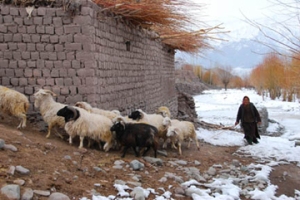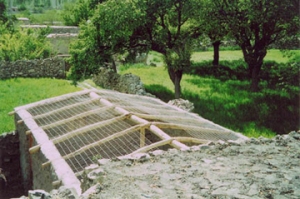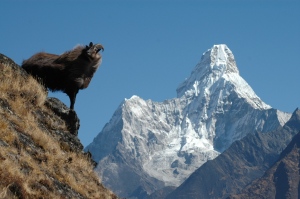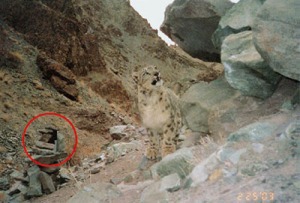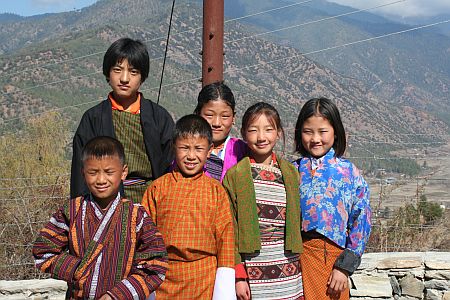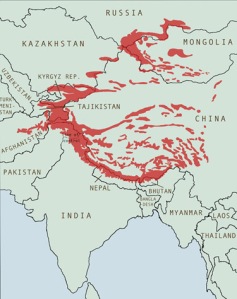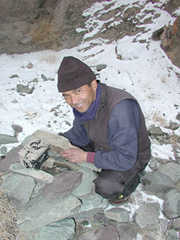
Jigmet Dadul, best snow leopard tracker in Ladakh. Photo kind permission of Snow Leopard Conservancy.
In 1997 I trekked in Hemis National Park, in Ladakh, in the northern Indian Himalayas. Along with 8 other volunteers and two snow leopard researchers (Dr Joe Fox and Dr Som Ale) we searched for scrapes, scat and any markings that told us that snow leopards still survived here in these awesome mountains after decades of being hunted for fur and body parts. We found a few signs but never saw the elusive cat. Not surprising as until recently even researchers working for decades in the wild seldom spotted these cats.
At that time the local villagers felt snow leopards were the enemy – the cats often killed domestic livestock if they weren’t able to get wild prey. Trekkers passing through these mountains had no idea that an animal called the snow leopard even existed let alone that this was one of its native habitats. There was huge uncertainty about their future. Could the beautiful snow leopard ever gain a claw hold for survival in these spectacular mountains?
But next February, in 2010 I’ll be there again…this time 12 years older, a bit rounder in the middle and in the dead of winter…yikes…
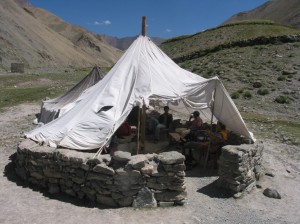
Cafe stop high on the trek. Parachute Cafe. Photo by kind permission of KarmaQuest.
12 years later so much has changed. Thanks to the Snow Leopard Conservancy (SLC) and other conservation groups the villagers today supplement their agricultural-based livelihoods by helping keep the snow leopard alive. They have home stay businesses where trekkers use traditional accommodation, eat local food and learn about the Ladakh way of life. Village women also have businesses tending parachute cafes for thirsty trekkers on high mountain trails. *
KarmaQuest Ecotourism and Adventure Travel, a US-based company has been running winter snow leopard tracking trips with one of the world’s most renowned snow leopard researchers, Dr Rodney Jackson, Director of the Snow Leopard Conservancy to this part of the world since 2005. And why go in winter? Well winter is the time snow leopards come down to lower altitude and offers the best chance of seeing these rare and endangered cats in the wild.
The other trip members and I will join the SLC-India staff on their winter monitoring activities, studying the snow leopard when it descends from the snowy mountaintops in search of food, studying prey species and the snow leopard’s habitat.
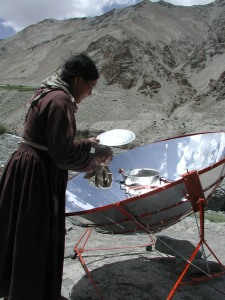
Solar cooking technology. Indian Himalayas. Photo by kind permission of Snow Leopard Conservancy.
No doubt we’ll all be thinking about the 2007 winter group that was lucky enough to observe a snow leopard eating its kill for more than an hour. Thus far KarmaQuest group members have seen a snow leopard every year! Considering that less than 100 Westerners had seen a snow leopard in the wild before 2005, this is a phenomenal rate of success! And all thanks to the years of study, tracking and conservation efforts by Dr. Jackson and his Ladakhi team, of which Jigmet Dadul – reputed to be the ‘best snow leopard tracker in Ladakh’– will be there to help us beat the odds.
There are still trip places available for this fantastic opportunity. Check out the website from the folks over at KarmaQuest and talk to Wendy Lama, an Ecotourism Specialist who has been travelling and working in this part of the world for many years. This is the trek of a lifetime, it would be wonderful if I saw you there too. The deadline for signing up is November 30, 2009.
*Parachute cafes – my other half wondered “are they cafes where adventure parachutists drop in to for a tea or latte?” No….they portable cafés made out of – you guessed it – parachute material.



 Posted by Sibylle and Rex
Posted by Sibylle and Rex 

